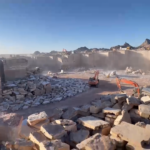Introduction
Afghanistan is home to some of the most exquisite marble in the world. Known for its durability and unique patterns, Afghan marble is a prized material in architecture and design. This post explores the distinct qualities of Afghan marble and its various applications.
A Rich Heritage
Afghanistan’s marble quarries have a long history, producing stone that has been used in notable historical structures. The country’s marble, including the renowned black golden marble, is celebrated for its exceptional quality and aesthetic appeal.
Key Features of Afghan Marble
- Durability: Afghan marble is incredibly durable, making it ideal for high-traffic areas and exterior applications. Its hardness ensures longevity, reducing the need for frequent repairs or replacements.
- Unique Patterns: Each slab of Afghan marble is unique, featuring natural veining and color variations that add character and elegance to any space. This uniqueness makes it a favorite among designers seeking one-of-a-kind pieces.
- Versatility: Afghan marble is versatile, suitable for various applications from flooring and countertops to sculptures and decorative elements. Its ability to be polished to a high sheen or honed to a matte finish adds to its appeal in different design contexts.
- Sustainability: As a natural stone, marble is an eco-friendly building material. Its long lifespan and minimal maintenance requirements contribute to its sustainability, making it a responsible choice for environmentally-conscious projects.
Applications of Afghan Marble
- Architecture: Afghan marble is used in architectural masterpieces worldwide. Its strength and beauty make it a preferred material for constructing facades, pillars, and flooring in both modern and classical buildings.
- Interior Design: In interior spaces, Afghan marble is used for countertops, bathroom vanities, and wall cladding. Its luxurious appearance adds a touch of elegance to kitchens, bathrooms, and living areas.
- Art and Sculpture: Artists and sculptors appreciate Afghan marble for its workability and stunning finish. The stone’s fine grain allows for intricate detailing, making it ideal for creating statues and decorative art pieces.
- Landscaping: Afghan marble is also used in landscaping for pathways, garden sculptures, and water features. Its natural beauty enhances outdoor spaces, creating serene and aesthetically pleasing environments.
Maintenance and Care
Maintaining Afghan marble is relatively simple. Regular cleaning with mild soap and water keeps it looking pristine. Sealing the marble periodically helps protect it from stains and scratches, ensuring it remains beautiful for years.
Conclusion
Afghan marble is a testament to natural beauty and resilience. Its unique patterns, durability, and versatility make it a sought-after material in architecture, interior design, and art. Whether you’re looking to enhance a modern space or add a timeless touch to a classical design, Afghan marble is a choice that combines elegance with functionality.


